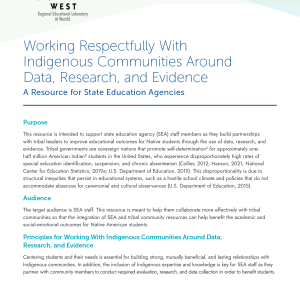Upcoming Resources Will Help SEAs Incorporate Native Americans into English Language Arts (ELA) Standards
Posted on

An upcoming 50-state scan will show how Native Americans are currently represented in English language arts (ELA) standards. A tool to help state education agencies meaningfully incorporate Native American themes, representations, authors, and texts in future standards is also being developed.
Despite the unique and important heritage and contemporary contributions of Native Americans to American history, literature, and culture, English language arts (ELA) standards in most states do not yet meaningfully reference, represent, or reflect valuable Native American culture, philosophies, or contributions essential to students’ education.
To help state education agencies (SEAs) achieve this important objective, this fall, the Region 13 Comprehensive Center (R13CC) is launching an effort to thoroughly examine and report on whether and how ELA standards in the 50 states represent Native Americans and their contributions.
The report will also document trends that have emerged from those standards. It will include
- an examination of state academic ELA standards across all 50 states, including those used by the Bureau of Indian Education
- analysis of how American Indians, Native Americans, Indigenous peoples, specific tribal nations, specific Native authors, and specific Native texts are currently utilized in such standards, and
- identification of themes relevant to those designing such standards, such as degree of rigor, and trends regarding in which grades and aspects of content—such as literature, informational texts, writing, speaking—Native American contributions are mentioned.
“By taking stock of good work that has already occurred, both to design evidence-based standards as well as to locate substantiating resources, we hope to save many other agencies significant time and effort as they work to realize the important objective of enabling all students to benefit from Native voices, experiences and learnings,” said Rob Salley, Deputy Director of the R13CC.
R13CC also intends to produce a new tool to help SEAs develop practical Native-inclusive ELA state standards to serve as a model for others doing this work. The tool will spotlight the data and research other SEAs have leveraged during the standards design phase.
“This project is an example of advancing equity for students at the systems level,” shared Dr. Brianne Dotson, Systems Change Senior Program Associate on WestEd’s Resource Planning and Implementation team. “Research has repeatedly shown that incorporating a variety of contributions from diverse groups of people has cognitive, social, and emotional benefits for all students.”
The Region 13 Comprehensive Center works with SEAs and their regional and local constituents in New Mexico, Oklahoma, and the Bureau of Indian Education to improve outcomes for all children and better serve communities through capacity-building technical assistance, content expertise, and other services.
“We are excited to highlight the trailblazing work of states that already incorporate the important contributions of Native Americans in their ELA standards and to support additional states in doing the same,” added Bejanae Kareem, Program Associate with WestEd’s Quality Schools and Districts team.
The contents of this blog post were developed under a grant from the Department of Education. However, the contents do not necessarily represent the policy of the Department of Education, and you should not assume endorsement by the federal government.


